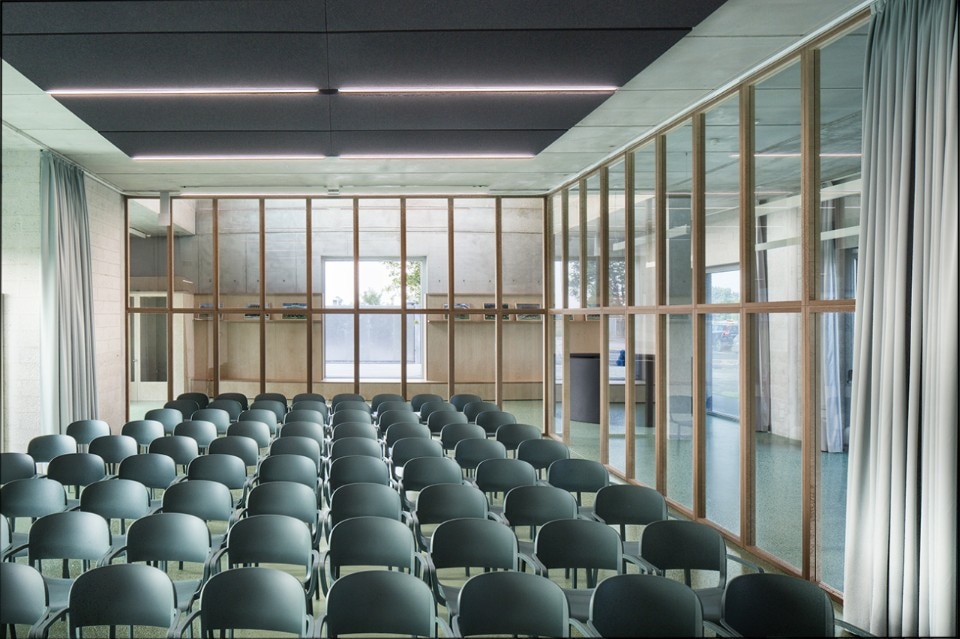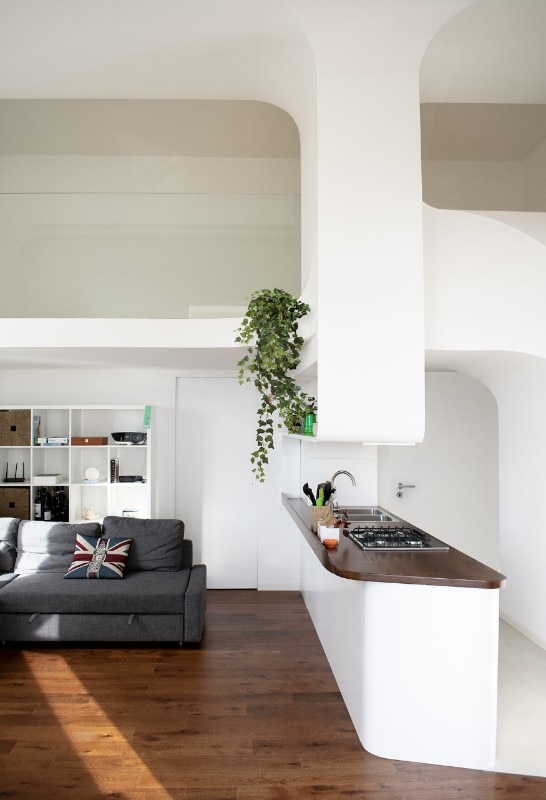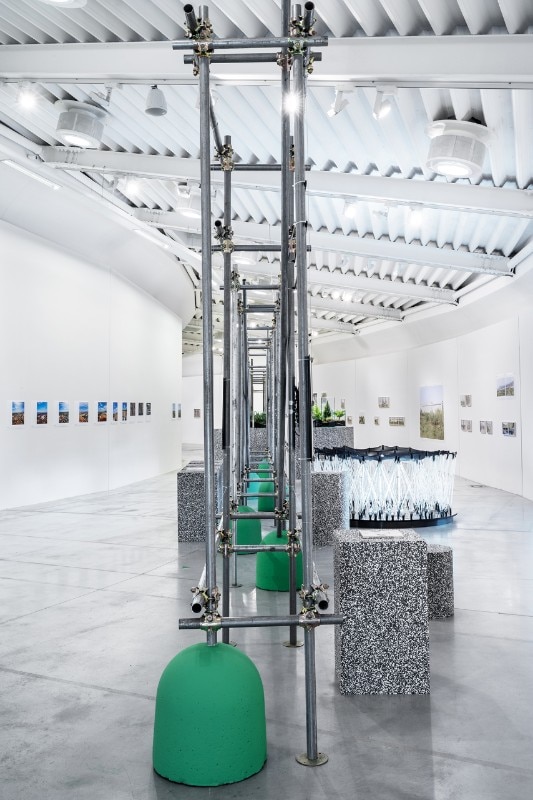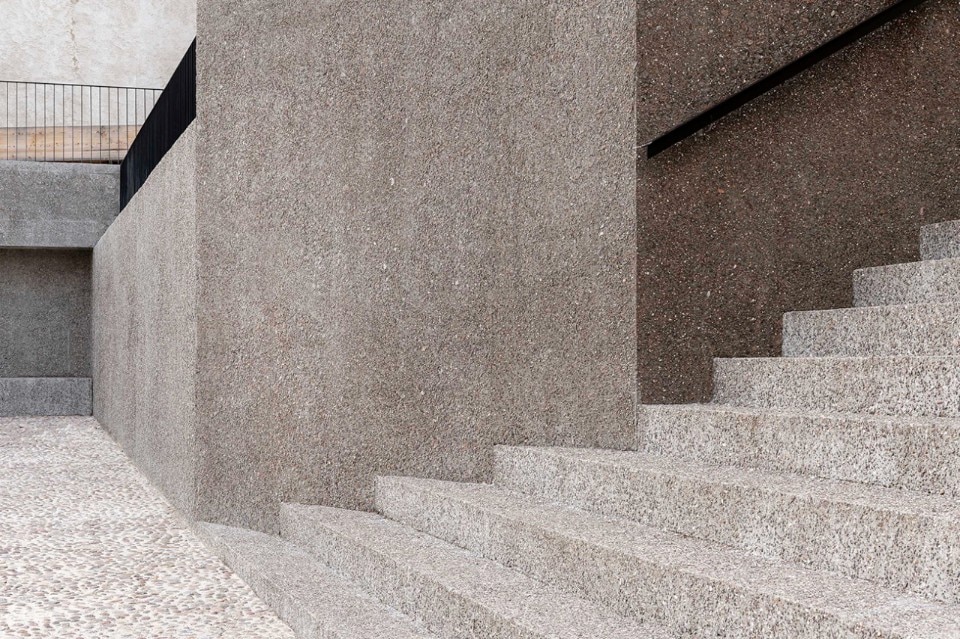
Innovation and sustainability in building materials
The new range of lime-based thermal plasters by Röfix is designed to provide advanced insulation solutions.
- Sponsored content
At the Palazzo dell’Arte in Milan, the collaboration between Triennale Milano and MAXXI is strengthened with the second edition of the Italian Architecture Award, together with the TYoung Award - promoted by the Claudio De Albertis Award Committee - and the Lifetime Achievement Award.
The prize for the best building of the Italian Architecture Award was assigned to LCM 2018, the Casa-Asilo di Maria Giuseppina Grasso Cannizzo in Mazzarrone (Catania). An “anonymous building” reinterpreted through a series of discreet interventions that reflect on the adaptation of a school structure to residential habitability.
The honorable mention went to Onsitestudio with the Mapei Football Center in Sassuolo (2019).
The president of the Claudio De Albertis Award Committee, Carla De Albertis, connected by videoconference with the winner of the last edition Simone Gobbo di Demogo, then announced the winner. Among 45 projects, the TYoung prize was awarded to Simona Della Rocca (BDR Bureau) for the Enrico Fermi School (2019) in Turin.
The honorable mention went to the Roman collective Orizzontale per Civico Civico (2020) in Riesi (Caltanissetta).
Finally, Paolo Portoghesi was awarded the Lifetime Achievement Award, who commented that he was grateful “to the two institutions, which by founding this award have tied Rome and Milan hand in hand” .
The finalist projects of the awards are on display at the Milan Triennale until 22 August 2021.
The winners of the prizes were announced at a press conference by the president of the Triennale Stefano Boeri, the president of the MAXXI Foundation Giovanna Melandri, Lorenza Baroncelli (artistic director of the Triennale Milano) and Carla De Albertis.
The jury of this edition of the Italian Architecture Award is composed of Stefano Boeri, Lorenza Baroncelli, Pippo Ciorra, Onofrio Cutaia, Francis Kéré, Fulvio Irace, Giovanna Melandri, Anaa Ramos, Lucy Styles, Francesca Torzo, Cino Zucchi and, for the award TYoung, Carla De Albertis, Simone Gobbo and Elena Tettamanti.

Maria Giuseppina Grasso Cannizzo, LCM 2018 / CASA-ASILO, Mazzarone, Catania, 2018
The transformation of a kindergarden into a home in Mazzarone. The jury recognizes “a value of civic and professional exemplarity for the ability to perceive the qualities of an anonymous building similar to the many portions of buildings spread throughout the Italian territory, reinterpreting them in a skilful orchestration of timely, discreet, inconspicuous interventions. A project that restores a sense of time and plurality to the life of the community. A work that invites us to reflect on the responsibility of the act of building in everyday reality ".
Photo Giulia Bruno

Maria Giuseppina Grasso Cannizzo, LCM 2018 / CASA-ASILO, Mazzarone, Catania, 2018
The transformation of a kindergarden into a home in Mazzarone. The jury recognizes “a value of civic and professional exemplarity for the ability to perceive the qualities of an anonymous building similar to the many portions of buildings spread throughout the Italian territory, reinterpreting them in a skilful orchestration of timely, discreet, inconspicuous interventions. A project that restores a sense of time and plurality to the life of the community. A work that invites us to reflect on the responsibility of the act of building in everyday reality ".
Photo Giulia Bruno

Maria Giuseppina Grasso Cannizzo, LCM 2018 / CASA-ASILO, Mazzarone, Catania, 2018
The transformation of a kindergarden into a home in Mazzarone. The jury recognizes “a value of civic and professional exemplarity for the ability to perceive the qualities of an anonymous building similar to the many portions of buildings spread throughout the Italian territory, reinterpreting them in a skilful orchestration of timely, discreet, inconspicuous interventions. A project that restores a sense of time and plurality to the life of the community. A work that invites us to reflect on the responsibility of the act of building in everyday reality ".
Photo Giulia Bruno

Maria Giuseppina Grasso Cannizzo, LCM 2018 / CASA-ASILO, Mazzarone, Catania, 2018
The transformation of a kindergarden into a home in Mazzarone. The jury recognizes “a value of civic and professional exemplarity for the ability to perceive the qualities of an anonymous building similar to the many portions of buildings spread throughout the Italian territory, reinterpreting them in a skilful orchestration of timely, discreet, inconspicuous interventions. A project that restores a sense of time and plurality to the life of the community. A work that invites us to reflect on the responsibility of the act of building in everyday reality ".
Photo Giulia Bruno

Simona Della Rocca (cofounder of BDR bureau with Alberto Bottero), Enrico Fermi Highschool, Turin, 2019
The project was selected by the jury "for its ability to positively integrate new educational needs within architectural research. The project is confronted in an incisive way with the existing structure, elegantly declining a changing material tonal range. Architecture, through its compositional outcome, suggests the importance of the school space in current dynamics, offers an interpretation that is useful for building new references on the training space ".
Photo Simone Bossi

Simona Della Rocca (cofounder of BDR bureau with Alberto Bottero), Enrico Fermi Highschool, Turin, 2019
The project was selected by the jury "for its ability to positively integrate new educational needs within architectural research. The project is confronted in an incisive way with the existing structure, elegantly declining a changing material tonal range. Architecture, through its compositional outcome, suggests the importance of the school space in current dynamics, offers an interpretation that is useful for building new references on the training space ".
Photo Simone Bossi

Simona Della Rocca (cofounder of BDR bureau with Alberto Bottero), Enrico Fermi Highschool, Turin, 2019
The project was selected by the jury "for its ability to positively integrate new educational needs within architectural research. The project is confronted in an incisive way with the existing structure, elegantly declining a changing material tonal range. Architecture, through its compositional outcome, suggests the importance of the school space in current dynamics, offers an interpretation that is useful for building new references on the training space ".
Photo Simone Bossi

Simona Della Rocca (cofounder of BDR bureau with Alberto Bottero), Enrico Fermi Highschool, Turin, 2019
The project was selected by the jury "for its ability to positively integrate new educational needs within architectural research. The project is confronted in an incisive way with the existing structure, elegantly declining a changing material tonal range. Architecture, through its compositional outcome, suggests the importance of the school space in current dynamics, offers an interpretation that is useful for building new references on the training space ".
Photo Simone Bossi

Onsitestudio, Mapei Football Center, 2019
The project is based on the relationship with the open and horizontal agricultural landscape, located in Sassuolo (Modena, Italy). Client U.S. Sassuolo Calcio. The sports complex consists of a main brick building, a concrete roffed tribune and a block containing an electric generator and MEP services.
Photo Filippo Romano, Stefano Graziani

Onsitestudio, Mapei Football Center, 2019
The project is based on the relationship with the open and horizontal agricultural landscape, located in Sassuolo (Modena, Italy). Client U.S. Sassuolo Calcio. The sports complex consists of a main brick building, a concrete roffed tribune and a block containing an electric generator and MEP services.
Photo Filippo Romano, Stefano Graziani

Onsitestudio, Mapei Football Center, 2019
The project is based on the relationship with the open and horizontal agricultural landscape, located in Sassuolo (Modena, Italy). Client U.S. Sassuolo Calcio. The sports complex consists of a main brick building, a concrete roffed tribune and a block containing an electric generator and MEP services.
Photo Filippo Romano, Stefano Graziani

Onsitestudio, Mapei Football Center, 2019
The project is based on the relationship with the open and horizontal agricultural landscape, located in Sassuolo (Modena, Italy). Client U.S. Sassuolo Calcio. The sports complex consists of a main brick building, a concrete roffed tribune and a block containing an electric generator and MEP services.
Photo Filippo Romano, Stefano Graziani

Orizzontale, CIVICO CIVICO, 2020
The building located in Riesi (Caltanisetta, Sicily), confiscted from organised crime, has been entrusted to Servizio Cristiano / Istituto Valdese for social purposes. The building, which is the result of speculation imposed by the Mafia, was subject to an intervention that , through small transformative actions, changed the use and perception of the place: from a private and introverted space to a permeable public place.
Photo Emanuele Piccardo

Orizzontale, CIVICO CIVICO, 2020
The building located in Riesi (Caltanisetta, Sicily), confiscted from organised crime, has been entrusted to Servizio Cristiano / Istituto Valdese for social purposes. The building, which is the result of speculation imposed by the Mafia, was subject to an intervention that , through small transformative actions, changed the use and perception of the place: from a private and introverted space to a permeable public place.
Photo Giulio Marzullo

Orizzontale, CIVICO CIVICO, 2020
The building located in Riesi (Caltanisetta, Sicily), confiscted from organised crime, has been entrusted to Servizio Cristiano / Istituto Valdese for social purposes. The building, which is the result of speculation imposed by the Mafia, was subject to an intervention that , through small transformative actions, changed the use and perception of the place: from a private and introverted space to a permeable public place.
Photo Giulio Marzullo

Binocle, Galleria Massimo De Carlo within Casa Corbellini-Wassermann, 2019
The project concerns the conservative restoration and transformation of the raised ground floor and basement of Casa Corbellini-Wassermann into the new headquarters of the Massimo De Carlo Gallery. The famous building was designed by Piero Portaluppi on behalf of Guido Corbellini and Paola Wassermann and built between 1934 and 1936 in viale Lombardia, Milan.
Photo Delfino Sisto Legnani e Marco Cappelletti

Binocle, Galleria Massimo De Carlo within Casa Corbellini-Wassermann, 2019
The project concerns the conservative restoration and transformation of the raised ground floor and basement of Casa Corbellini-Wassermann into the new headquarters of the Massimo De Carlo Gallery. The famous building was designed by Piero Portaluppi on behalf of Guido Corbellini and Paola Wassermann and built between 1934 and 1936 in viale Lombardia, Milan.
Photo Delfino Sisto Legnani e Marco Cappelletti

Binocle, Galleria Massimo De Carlo within Casa Corbellini-Wassermann, 2019
The project concerns the conservative restoration and transformation of the raised ground floor and basement of Casa Corbellini-Wassermann into the new headquarters of the Massimo De Carlo Gallery. The famous building was designed by Piero Portaluppi on behalf of Guido Corbellini and Paola Wassermann and built between 1934 and 1936 in viale Lombardia, Milan.
Photo Delfino Sisto Legnani e Marco Cappelletti

Teke Architects Office, Modular Unit - MU50, 2019
Perched high on a steep cliff offering stunning views, Modular Unit (MU50) is a small-scale structure designed to be recyclable and adaptable.
Photo Altkat Architectural Photography

Teke Architects Office, Modular Unit - MU50, 2019
Perched high on a steep cliff offering stunning views, Modular Unit (MU50) is a small-scale structure designed to be recyclable and adaptable.
Photo Altkat Architectural Photography

Teke Architects Office, Modular Unit - MU50, 2019
Perched high on a steep cliff offering stunning views, Modular Unit (MU50) is a small-scale structure designed to be recyclable and adaptable.
Photo Altkat Architectural Photography

ZAA Zamboni Associati Architettura, Chiostri di San PietroCrediti, 2019
The intervention concerns the restoration of Cloisters of San Pietro, the most extraordinary monumental complex in the city of Reggio Emilia, with the aim of creating a cultural venue of international relevance, strengthening the natural vocation of the ancient Benedictine monastery.
Photo Alessandra Chemollo, Kai-Uwe Schulte Bunert

ZAA Zamboni Associati Architettura, Chiostri di San PietroCrediti, 2019
The intervention concerns the restoration of Cloisters of San Pietro, the most extraordinary monumental complex in the city of Reggio Emilia, with the aim of creating a cultural venue of international relevance, strengthening the natural vocation of the ancient Benedictine monastery.
Photo Alessandra Chemollo, Kai-Uwe Schulte Bunert

ZAA Zamboni Associati Architettura, Chiostri di San PietroCrediti, 2019
The intervention concerns the restoration of Cloisters of San Pietro, the most extraordinary monumental complex in the city of Reggio Emilia, with the aim of creating a cultural venue of international relevance, strengthening the natural vocation of the ancient Benedictine monastery.
Photo Alessandra Chemollo, Kai-Uwe Schulte Bunert

Boano Prišmontas, The Arches Project, 2018
The project, located in London, consists of the production and installation of a modular system of custom made birch plywood cut with CNC technology to reconvert unused spaces at 510 Ridgway Road
Photo Mario Coppola

Boano Prišmontas, The Arches Project, 2018
The project, located in London, consists of the production and installation of a modular system of custom made birch plywood cut with CNC technology to reconvert unused spaces at 510 Ridgway Road
Photo Mario Coppola

Boano Prišmontas, The Arches Project, 2018
The project, located in London, consists of the production and installation of a modular system of custom made birch plywood cut with CNC technology to reconvert unused spaces at 510 Ridgway Road
Photo Mario Coppola

Mario Coppola, Casa Noce, 2020
Casa Noce is the last step of a ten years long research on the transformations of architectural languages in the ecological transition era. The project is an apartment with a suspended mezzanine designed with ecological materials and low-cost mixed technologies (traditional craftsmanship, 3D printing and CNC cutting).
Photo Mario Coppola

Mario Coppola, Casa Noce, 2020
Casa Noce is the last step of a ten years long research on the transformations of architectural languages in the ecological transition era. The project is an apartment with a suspended mezzanine designed with ecological materials and low-cost mixed technologies (traditional craftsmanship, 3D printing and CNC cutting).
Photo Mario Coppola

Mario Coppola, Casa Noce, 2020
Casa Noce is the last step of a ten years long research on the transformations of architectural languages in the ecological transition era. The project is an apartment with a suspended mezzanine designed with ecological materials and low-cost mixed technologies (traditional craftsmanship, 3D printing and CNC cutting).
Photo Mario Coppola

Fosbury Architecture, Verde Prato, 2019
The installation project at the Luigi Pecci Center for Contemporary Art in Prato has a monumental character that induces the public to stop in the exhibition space and inhabit its ephemeral monuments.
Photo OKNO studio

Fosbury Architecture, Verde Prato, 2019
The installation project at the Luigi Pecci Center for Contemporary Art in Prato has a monumental character that induces the public to stop in the exhibition space and inhabit its ephemeral monuments.
Photo OKNO studio

Fosbury Architecture, Verde Prato, 2019
The installation project at the Luigi Pecci Center for Contemporary Art in Prato has a monumental character that induces the public to stop in the exhibition space and inhabit its ephemeral monuments.
Photo OKNO studio

Romina Grillo, Renovation and extension of a Villa in Galliate, 2018
The renovation of a 1910 villa located on the edge of Galliate (Novara, Italy) and facing the agricultural landscape involves the complete rearrangement of the ground floor, including its external areas and the addition of a veranda through an exposed reinforced concrete structure.
Photo Foto Marco Cappelletti and Delfino Sisto Legnani

Romina Grillo, Renovation and extension of a Villa in Galliate, 2018
The renovation of a 1910 villa located on the edge of Galliate (Novara, Italy) and facing the agricultural landscape involves the complete rearrangement of the ground floor, including its external areas and the addition of a veranda through an exposed reinforced concrete structure.
Photo Foto Marco Cappelletti and Delfino Sisto Legnani

Romina Grillo, Renovation and extension of a Villa in Galliate, 2018
The renovation of a 1910 villa located on the edge of Galliate (Novara, Italy) and facing the agricultural landscape involves the complete rearrangement of the ground floor, including its external areas and the addition of a veranda through an exposed reinforced concrete structure.
Photo Foto Marco Cappelletti and Delfino Sisto Legnani

Mauro Marinelli (studiofranzosomarinelli), New plazas and public spaces in Castelfondo, 2020
The project is located in a small village in the Trentino Alps and is articulated around walls that define three squares. The opportunity arises from the need to demolish a dilapidated building thus regenerating the settlement fabric to provide the community with new meeting spaces.
Photo Mariano Dallago

Mauro Marinelli (studiofranzosomarinelli), New plazas and public spaces in Castelfondo, 2020
The project is located in a small village in the Trentino Alps and is articulated around walls that define three squares. The opportunity arises from the need to demolish a dilapidated building thus regenerating the settlement fabric to provide the community with new meeting spaces.
Photo Mariano Dallago

Mauro Marinelli (studiofranzosomarinelli), New plazas and public spaces in Castelfondo, 2020
The project is located in a small village in the Trentino Alps and is articulated around walls that define three squares. The opportunity arises from the need to demolish a dilapidated building thus regenerating the settlement fabric to provide the community with new meeting spaces.
Photo Mariano Dallago

Onsitestudio, Pirelli Learning Center, 2020
The new corporate building is located inside a historic industrial neighborhood north of Milan, Bicocca, transformed at the end of the 80s into a district following the masterplan designed by Vittorio Gregotti.
Courtesy Pirelli Learning Center

Onsitestudio, Pirelli Learning Center, 2020
The new corporate building is located inside a historic industrial neighborhood north of Milan, Bicocca, transformed at the end of the 80s into a district following the masterplan designed by Vittorio Gregotti.
Courtesy Pirelli Learning Center

Onsitestudio, Pirelli Learning Center, 2020
The new corporate building is located inside a historic industrial neighborhood north of Milan, Bicocca, transformed at the end of the 80s into a district following the masterplan designed by Vittorio Gregotti.
Courtesy Pirelli Learning Center

Accademia Tadini on Lake Iseo reborn with Isotec
Brianza Plastica's Isotec thermal insulation system played a key role in the restoration of Palazzo Tadini, a masterpiece of Lombard neoclassical architecture and a landmark of the art world.
- Sponsored content










